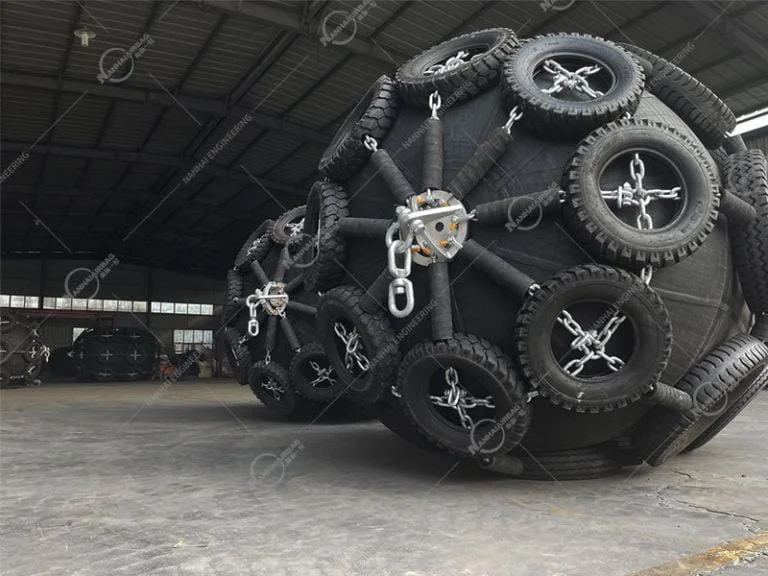Marine Airbags: Packaging, Transport and Storage
06/05/2025Vulcanization Process Of Pneumatic Rubber Fenders
06/06/2025What are the main parts of the inspection of marine fenders?
Ensuring the safety and efficiency of maritime operations hinges on the proper maintenance of marine fenders. These critical components absorb the kinetic energy of vessels during berthing, safeguarding both the ship and the dock. Regular inspections are paramount to detect wear and prevent potential failures.
Why Is Marine Fender Inspection Necessary?
Consider a scenario where a vessel docks at a port with compromised fenders. The resulting impact could damage the ship’s hull or the dock infrastructure, leading to costly repairs and operational delays. Regular inspections mitigate such risks by identifying issues before they escalate.
Main Components of Marine Fenders Inspection
1. Visual Examination of Fender Body
Inspect for signs of wear, cracks, or deformation on the fender’s surface. For pneumatic rubber fenders, check for air leaks or pressure loss. Regular visual checks help in the early detection of potential failures.
2. Assessment of Mounting Hardware
Ensure that all bolts, chains, and brackets securing the fender are intact and free from corrosion. Loose or damaged hardware can compromise the fender’s performance.
3. Evaluation of Frontal Panels and Accessories
Check frontal panels for dents, cracks, or corrosion. Damaged panels can reduce energy absorption efficiency. Regular maintenance, including anti-corrosion treatments, prolongs their lifespan.
4. Inspection of Rubber Components
Examine rubber elements for signs of aging, such as ozone cracks or hardening. These issues can diminish the fender’s elasticity and energy absorption capacity.
5. Pressure Testing for Pneumatic Fenders
Regularly measure the internal pressure of pneumatic fenders to ensure they are within operational limits. Pressure deviations can indicate leaks or structural issues.
6. Functional Performance Evaluation
Conduct performance tests to assess the fender’s energy absorption and reaction force characteristics. This ensures the fender meets the required specifications for safe vessel berthing.
Factory Tests for Marine Fenders According to ISO 17357
According to ISO 17357:2002, manufacturers must conduct the following tests before delivering marine fenders:
1. Rubber Material Tests
Manufacturers test both the outer and inner rubber layers to ensure they meet specified standards for strength and durability.
2. Dimensional Inspection
Manufacturers measure the fender’s length and diameter at the initial internal pressure. The acceptable tolerances are:
- Length: +10%, -5%
- Diameter: +10%, -5%
They take at least two measurements at the middle section of the fender and calculate the average.
3. Air Tightness Test
Manufacturers inflate the fender to its initial pressure and monitor it for 30 minutes to ensure there is no air leakage.
4. Hydrostatic Pressure Test
Manufacturers fill the fender with water and increase the internal pressure to 10 kPa, recording the longitudinal and circumferential lengths. They then maintain the pressure for 10 minutes, ensuring there is no water leakage and the fender remains undamaged.

People Also Ask
How often should marine fenders be inspected?
Initial inspections should occur upon installation. Subsequent checks vary: daily visual inspections, periodic detailed assessments (monthly or quarterly), and comprehensive annual evaluations.
What are common signs of fender deterioration?
Indicators include surface cracks, deformation, air pressure loss in pneumatic fenders, corrosion on metal components, and reduced energy absorption during berthing.
Can damaged fenders be repaired, or should they be replaced?
Minor damages can often be repaired, especially in pneumatic fenders. However, extensive wear or structural compromise may necessitate replacement to ensure safety.
What is the lifespan of a marine fender?
With proper maintenance, marine fenders can last between 10 to 15 years. Factors influencing lifespan include environmental conditions, frequency of use, and maintenance practices.
Regular inspection and maintenance of marine fenders are crucial for the safety and efficiency of maritime operations. By adhering to a structured inspection regimen, potential issues can be identified and addressed promptly, ensuring the longevity and reliability of fender systems.
